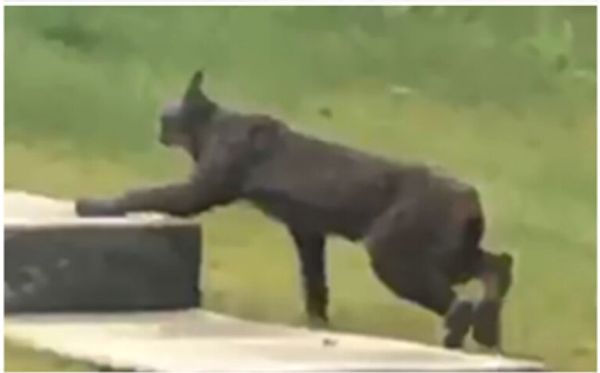
The Canada Lynx, or Lynx canadensis, is a majestic creature native to North America, gracing the wilderness of Canada and parts of the United States. While these lynx typically sport a light brownish-gray fur coat, black-furred individuals have been reported sporadically. However, until now, capturing photographic evidence of a black Canada Lynx had remained an elusive feat.
But in 2022, the impossible happened. An incredibly fortunate individual managed to snap some images of this captivating black beauty, causing a sensation across the internet. The fortunate witness? Thomas Jung, a researcher from the University of Alberta, Canada. The images were promptly shared, gaining instant viral status.
The incident took place in a tranquil residential area near the bustling metropolis of Whitehorse, located in the Yukon region. There, amidst the serenity of the neighborhood, the lynx was caught on camera at a distance of approximately 50 meters. In the footage, the lynx can be seen relaxing, unaware of the observer’s presence. However, the tranquility was interrupted when a nearby dog began to bark, causing the lynx to swiftly retreat into the wilderness.
While experts were able to confirm that the animal captured on video was indeed a Canada Lynx, the blurry footage made it challenging to discern any distinctive characteristics. Thomas Jung’s report in the journal Mammalia sheds some light on the lynx’s appearance: “It had a black coat containing whitish gray guard hairs throughout, as well as whitish gray hairs in the facial ruff and the rostrum and dorsal regions.”
Typically, lynx species exhibit similar coloring, with Canada lynx sporting silvery gray coats during winter. However, as summer arrives, their coats take on a reddish-brown hue. The black-coated lynx featured in the video is exceptionally rare, exhibiting a unique variation in coat color. Jung suggests that such variations may either serve as advantageous adaptations or disadvantageous traits in evolutionary terms.
Interestingly, scientists have yet to determine the exact benefits or drawbacks of melanism in animals. However, Jung leans toward viewing the black coat as a maladaptive feature due to the lack of essential camouflage it provides. In winter, while hunting in the snow, this lynx may stand out more prominently due to its darker hair.
The discovery of the black Canada Lynx captured on camera is truly remarkable. It serves as a testament to the incredible diversity found in nature. Have you ever encountered a unique creature in the wild? Share your thoughts and experiences in the comments below!







